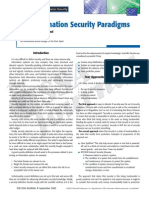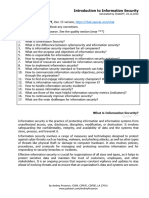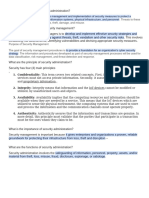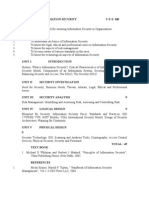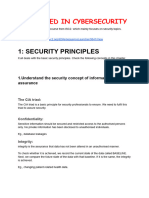2.1 Need For Security
2.1 Need For Security
Uploaded by
benita.aCopyright:
Available Formats
2.1 Need For Security
2.1 Need For Security
Uploaded by
benita.aOriginal Title
Copyright
Available Formats
Share this document
Did you find this document useful?
Is this content inappropriate?
Copyright:
Available Formats
2.1 Need For Security
2.1 Need For Security
Uploaded by
benita.aCopyright:
Available Formats
DEPARTMENT NAME
Class: Batch:
Course code: Course Title:
UNIT II SECURITY INVESTIGATION
Security Investigation: Need for Security – Business Needs – Threats – Attacks – Legal, Ethical
and Professional Issues in Information Security – Selecting Risk Control Strategy – Risk
Management – Recom mended Risk Control Practices.
Security investigation means the investigative procedures conducted by the competent authority of a
Member State in accordance with its national law and regulations in order to obtain an assurance that
nothing adverse is known which would prevent an individual from being granted a security clearance up
to a specified level (CONFIDENTIEL UE/EU CONFIDENTIAL or higher).
Five Phase Investigation Process
Phase I: Preparation and Planning.
Phase II: Information Gathering and Problem Identification.
Phase III: Verification and Analysis.
Phase IV: Disbursement of Disciplinary and Corrective Action.
Phase V: Prevention and Education.
The 3 types of investigations
Scientists use three types of investigations to research and develop explanations for events in the
nature:
Descriptive investigation,
Comparative investigation, and
Experimental investigation.
Types of Security:
Physical security-Physical security refers to measures that protect physical assets, such as
buildings, property, and people. This can include things like locks, cameras, alarms, and guards.
Cyber security-Cyber security is becoming increasingly important in today’s world, as more
and more transactions and activities are conducted online. Cyber security measures protect
against cyber-attacks, such as hacking and malware.
Prepared By: Page 1
DEPARTMENT NAME
Class: Batch:
Course code: Course Title:
Personal security-Personal security refers to measures that protect individuals, such as self-
defense training and personal alarm systems.
The Role of Investigations:
Investigations are a crucial part of security, as they help to uncover the root cause of a problem
and determine the best course of action to prevent future incidents. Investigations can take many
different forms, including criminal investigations, fraud investigations, and background checks.
Criminal investigations are conducted by law enforcement agencies and are used to gather
evidence in criminal cases.
Fraud investigations are conducted by companies or organizations to detect and prevent
fraudulent activities. These investigations may involve the use of forensic accounting, digital
forensics, and other techniques to uncover evidence of fraud.
The Benefits of Security and Investigations
1. Risk Mitigation:
o Security investigations help identify vulnerabilities and potential risks. By proactively
addressing these issues, organizations can prevent security breaches, data leaks, and
financial losses.
2. Incident Response:
o When incidents occur (such as cyber-attacks or unauthorized access), investigations
play a crucial role in understanding the scope, impact, and root causes. Effective
incident response minimizes damage and aids in recovery.
3. Fraud Detection and Prevention:
o Investigative techniques are vital for detecting fraudulent activities. Whether it’s
financial fraud, identity theft, or insurance scams, investigations help uncover
irregularities and protect individuals and businesses.
4. Compliance and Legal Requirements:
o Organizations must adhere to legal and regulatory standards. Security investigations
ensure compliance by monitoring activities, assessing risks, and maintaining
transparency.
5. Employee Safety and Workplace Security:
o Investigations contribute to a safe work environment. They address workplace
misconduct, harassment, and other issues, promoting employee well-being.
6. Intellectual Property Protection:
o Investigating intellectual property theft or infringement safeguards innovations,
patents, and trade secrets. It preserves an organization’s competitive edge.
Prepared By: Page 2
DEPARTMENT NAME
Class: Batch:
Course code: Course Title:
7. Cyber security Enhancement:
o Investigating cyber threats, malware, and breaches helps improve security protocols.
Lessons learned from investigations lead to better defences.
8. Insight for Decision-Making:
o Investigations provide valuable data. Analysing patterns and trends informs strategic
decisions, resource allocation, and risk management.
2.1 NEED FOR SECURITY
The purpose of information security management is to ensure business continuity and reduce business
damage by preventing and minimizing the impact of security incidents. The Audit Commission Update
report (1998) shows that fraud or cases of IT abuse often occur due to the absence of basic controls,
with one half of all detected frauds found by accident. An Information Security Management System
(ISMS) enables information to be shared, whilst ensuring the protection of information and computing
assets.
At the most practical level, securing the information on your computer means:
Ensuring that your information remains confidential and only those who should access that
information can.
Knowing that no one has been able to change your information, so you can depend on its
accuracy (information integrity).
Making sure that your information is available when you need it (by making back-up copies and,
if appropriate, storing the back-up copies off-site).
The basic principle of Information Security is:
Confidentiality: Confidentiality refers to protecting sensitive information from unauthorized access
or disclosure. This involves keeping confidential data secure and accessible only to those who are
authorized to access it.
Authentication: Authentication is a crucial aspect of the principle of Information Security and is
used to verify the identity of individuals or systems attempting to access sensitive information or
systems. It is a process of verifying that a person or system is who or what it claims to be.
Authentication is a critical component of Confidentiality and Availability as it helps prevent
unauthorized access to sensitive information and systems.
Non-Repudiation: Non-repudiation is a principle of Information Security that refers to the ability to
prove that an action or transaction took place and that it was performed by a specific individual or
Prepared By: Page 3
DEPARTMENT NAME
Class: Batch:
Course code: Course Title:
system. The term “non-repudiation” implies that an action or transaction cannot be denied by the
individual or system that performed it.
Integrity: Integrity refers to the accuracy and completeness of information and the prevention of
unauthorized or accidental modification of data. This ensures that data is not tampered with and
remains trustworthy.
The need for Information security:
Information security is essential for protecting sensitive and valuable data from unauthorized
access, use, disclosure, disruption, modification, or destruction. Here are some of the key
reasons why information security is important:
Protecting Confidential Information: Confidential information, such as personal data,
financial records, trade secrets, and intellectual property, must be kept secure to prevent it
from falling into the wrong hands. This type of information is valuable and can be used for
identity theft, fraud, or other malicious purposes.
Complying with Regulations: Many industries, such as healthcare, finance, and government,
are subject to strict regulations and laws that require them to protect sensitive data. Failure to
comply with these regulations can result in legal and financial penalties, as well as damage to the
organization’s reputation.
Maintaining Business Continuity: Information security helps ensure that critical business
operations can continue in the event of a disaster, such as a cyber-attack or natural disaster.
Without proper security measures in place, an organization’s data and systems could be
compromised, leading to significant downtime and lost revenue.
Protecting Customer Trust: Customers expect organizations to keep their data safe and secure.
Breaches or data leaks can erode customer trust, leading to a loss of business and damage to the
organization’s reputation
Preventing Cyber-attacks: Cyber-attacks, such as viruses, malware, phishing, and ransom
ware, are becoming increasingly sophisticated and frequent. Information security helps prevent
these attacks and minimizes their impact if they do occur.
Protecting Employee Information: Organizations also have a responsibility to protect
employee data, such as payroll records, health information, and personal details. This information
is often targeted by cybercriminals, and its theft can lead to identity theft and financial fraud.
Prepared By: Page 4
DEPARTMENT NAME
Class: Batch:
Course code: Course Title:
Prepared By: Page 5
You might also like
- Dangerous PersonalitiesDocument8 pagesDangerous PersonalitiesambroseedohNo ratings yet
- Introduction To Security: A. Security in General 1. Definition of SecurityDocument7 pagesIntroduction To Security: A. Security in General 1. Definition of SecurityDivina Dugao100% (1)
- Foundation of Information Security: Learning ObjectivesDocument12 pagesFoundation of Information Security: Learning ObjectivesJenny ApiladoNo ratings yet
- 200 IT Security Job Interview Questions-1Document188 pages200 IT Security Job Interview Questions-1yasmine ayedNo ratings yet
- Lesson One IasDocument6 pagesLesson One IasRicHArdNo ratings yet
- Information Security AssementDocument2 pagesInformation Security AssementDilip RanjanNo ratings yet
- Lecture 1 - Information Security BasicsDocument8 pagesLecture 1 - Information Security BasicsI careNo ratings yet
- IT SecurityDocument6 pagesIT SecurityRicky PrasojoNo ratings yet
- Nformation SystemDocument6 pagesNformation Systemsaranyaksr92No ratings yet
- Comp 324 - Information SecurityDocument57 pagesComp 324 - Information Securitymaxkrish shepherdNo ratings yet
- Information Security PDFDocument13 pagesInformation Security PDFPrabhath MadhusankaNo ratings yet
- Unit 4Document6 pagesUnit 4dhritihimasus1No ratings yet
- Information Assurance and Security II Lectures Quizzes and Activities Compress 1Document26 pagesInformation Assurance and Security II Lectures Quizzes and Activities Compress 1Jireh SalinasNo ratings yet
- Chapter 1 - Security PrinciplesDocument14 pagesChapter 1 - Security PrinciplesgabrielgngrNo ratings yet
- CH 2Document50 pagesCH 2derebelay8No ratings yet
- Security in PracticeDocument3 pagesSecurity in PracticeAnalyst AMMoonNo ratings yet
- 1Document44 pages1Sanjitha SNo ratings yet
- IAS - Module No 1-2Document10 pagesIAS - Module No 1-2John Kenneth CabreraNo ratings yet
- Ias Lesson5Document12 pagesIas Lesson5adeyantigo05No ratings yet
- Information Assurance and SecurityDocument3 pagesInformation Assurance and Securitympcivpacademics.nfjpia2324No ratings yet
- Chapter 1 - 3Document25 pagesChapter 1 - 3Kicave BlogNo ratings yet
- Met AverseDocument65 pagesMet AverseTram VNo ratings yet
- Enterprise Information Security-2Document10 pagesEnterprise Information Security-2Guillermo ValdèsNo ratings yet
- Chapter 1Document5 pagesChapter 1Nester OaNo ratings yet
- CSC2308 Lec 03Document64 pagesCSC2308 Lec 03aabdurrahaman647No ratings yet
- Aceituno Canal - On Information Security ParadigmsDocument4 pagesAceituno Canal - On Information Security Paradigmsjanardhan_johnnyNo ratings yet
- Session 1 - Information System Security Over ViewDocument7 pagesSession 1 - Information System Security Over ViewmunyakatimNo ratings yet
- CyberSecurity CourseDocument4 pagesCyberSecurity CourseXolani LungaNo ratings yet
- ISF Question Bank (3 Units)Document7 pagesISF Question Bank (3 Units)rohitkpawar04No ratings yet
- Chapter One: Introduction To Information Assurance and Security (ITEC4143)Document19 pagesChapter One: Introduction To Information Assurance and Security (ITEC4143)Dires NegashNo ratings yet
- Ias IiDocument34 pagesIas IimodestoalmajeanNo ratings yet
- Content Area 5-6: What Is Security?Document25 pagesContent Area 5-6: What Is Security?wajidjavaidiqbalNo ratings yet
- 601 Unit 3 IntroductionDocument10 pages601 Unit 3 IntroductioninduguptaddhkpNo ratings yet
- Task 1 - Juan Estevan Gomez HincapieDocument5 pagesTask 1 - Juan Estevan Gomez Hincapiejuan estevan gomez hincapieNo ratings yet
- Basics of Infosec SummaryDocument8 pagesBasics of Infosec Summaryhauwauibrahimmagaji532No ratings yet
- Chapter 1 - Introduction To Information SecurityDocument3 pagesChapter 1 - Introduction To Information SecuritydwenbeagarciaNo ratings yet
- FS 2 1ST UnitDocument19 pagesFS 2 1ST UnitrhyborromeoNo ratings yet
- CS Unit-IDocument24 pagesCS Unit-Iajjugamer171No ratings yet
- Introduction To Information SecurityDocument11 pagesIntroduction To Information Securityroneycruz.govticNo ratings yet
- Presentation 1Document37 pagesPresentation 1Evehn KadusaleNo ratings yet
- Intro To Security MGTDocument4 pagesIntro To Security MGTmaribel.nerozaNo ratings yet
- Registration SeminarDocument29 pagesRegistration SeminarDebasish JenaNo ratings yet
- CS1014 Information Security 3 0 0 100 AIMDocument19 pagesCS1014 Information Security 3 0 0 100 AIMMuthu SaanaNo ratings yet
- Energies 15 09238 v2Document6 pagesEnergies 15 09238 v2mesfin godatoNo ratings yet
- Information SecurityDocument189 pagesInformation Securitychughtaikhan435No ratings yet
- Study Material 2Document27 pagesStudy Material 2SachinNo ratings yet
- Certified in CybersecurityDocument56 pagesCertified in CybersecurityminojnextNo ratings yet
- Information Security and ControlsDocument19 pagesInformation Security and ControlsHarris ChikunyaNo ratings yet
- 646b7124add15 Cyber-SecurityDocument16 pages646b7124add15 Cyber-SecurityUsman AleeNo ratings yet
- Chapter 1 UPDocument9 pagesChapter 1 UPidrisabdurazek0123No ratings yet
- Vphysical ControlsDocument3 pagesVphysical ControlssamieclayNo ratings yet
- Chapter-1-Introduction and Security Trends NotesDocument69 pagesChapter-1-Introduction and Security Trends NotesVrushaliNo ratings yet
- Cs&CryptLec1Document26 pagesCs&CryptLec1Ferdaws OmarNo ratings yet
- Lesson 1 - Introduction To IASDocument38 pagesLesson 1 - Introduction To IASGinger BreadNo ratings yet
- DocumentDocument7 pagesDocumentMarijo Bugarso BSIT-3BNo ratings yet
- Eccouncil Ecihv2 1 1 1 Information Security and Incident ManagementDocument3 pagesEccouncil Ecihv2 1 1 1 Information Security and Incident ManagementteketamiruNo ratings yet
- Lecture 1-2Document36 pagesLecture 1-2sumrun sahabNo ratings yet
- Cyber Security Lecture Notes 01Document19 pagesCyber Security Lecture Notes 01Sampath Darshana100% (1)
- It2042 Unit1Document32 pagesIt2042 Unit1Udemy FreeNo ratings yet
- Lecture 01Document35 pagesLecture 01MD. HABIB ULLAH YEASINNo ratings yet
- BE Khushboo Chouhan JLU05126Document3 pagesBE Khushboo Chouhan JLU05126Abhishek BidhanNo ratings yet
- Rivera Vs Atty DalanginDocument3 pagesRivera Vs Atty DalanginLEVI ACKERMANNNo ratings yet
- Case Study - Group 2Document11 pagesCase Study - Group 2Jeni Ross FinoNo ratings yet
- WA - W.P. 15642 of 2021 - Raj Kumar YadavDocument13 pagesWA - W.P. 15642 of 2021 - Raj Kumar Yadavnagdgreat pNo ratings yet
- Bus Ethics - Module 7 - Major Ethical Issues in The Corporate WorldDocument6 pagesBus Ethics - Module 7 - Major Ethical Issues in The Corporate WorldKJ Jones100% (1)
- TOBIDocument7 pagesTOBIreginacastrochavez915No ratings yet
- History - II Project WorkDocument28 pagesHistory - II Project WorkSWETCHCHA MISKANo ratings yet
- No Game No Life - Volume 10Document273 pagesNo Game No Life - Volume 10Mahmudmamuddie Aladeenlalaski100% (2)
- 78 Historias de Tatoy Versión InglésDocument50 pages78 Historias de Tatoy Versión InglésBLANCHE Urrutia100% (1)
- People V Nitafan 207 Scra 726Document1 pagePeople V Nitafan 207 Scra 726MylesNo ratings yet
- ESTAFADocument10 pagesESTAFANelson LaurdenNo ratings yet
- Court Addendum GenericDocument4 pagesCourt Addendum GenericplugnotNo ratings yet
- RPC Elements FlashcardsDocument126 pagesRPC Elements FlashcardsLyn Jo100% (1)
- PD 807 Sec 36 PPT ReportDocument69 pagesPD 807 Sec 36 PPT ReportXyrelle Jane A. AbanNo ratings yet
- EDD Task Force Letter 12.03.2020Document5 pagesEDD Task Force Letter 12.03.2020ABC10No ratings yet
- Questioned Documents Examination NotesDocument11 pagesQuestioned Documents Examination Notesjaysonalmadin0No ratings yet
- Gre List-单词听写精选List 17-32 - 单词Document3 pagesGre List-单词听写精选List 17-32 - 单词lightNo ratings yet
- M4 AMLA Unlawful ActivitiesDocument37 pagesM4 AMLA Unlawful Activitiesjulia4razoNo ratings yet
- PP AssignmentDocument5 pagesPP AssignmentIfra MalikNo ratings yet
- Cemds Acc 2022 019TDocument82 pagesCemds Acc 2022 019TClaire Denisse AilesNo ratings yet
- Introduction To Forensic Accounting Week 1Document24 pagesIntroduction To Forensic Accounting Week 1Logeswaran RajanNo ratings yet
- Sample Notice & Demand To Validate Debt ClaimDocument5 pagesSample Notice & Demand To Validate Debt ClaimLMA TRUCKING INC100% (6)
- 02 Tagatac Vs JimenezDocument5 pages02 Tagatac Vs JimenezIronFaith19No ratings yet
- FirstEnergy Is Not A Victim, Former Executives SayDocument17 pagesFirstEnergy Is Not A Victim, Former Executives SayjbalmertNo ratings yet
- Art. 28, NCCDocument1 pageArt. 28, NCCPrinsesaJuuNo ratings yet
- 18 Worst MistakesDocument24 pages18 Worst MistakesalanNo ratings yet
- Redzone Podcast Episode #89: Stop Playing To Lose Play To Win: High Performance Leadership Tactics From The 50 Billion Dollar Man - With Dan PeñaDocument24 pagesRedzone Podcast Episode #89: Stop Playing To Lose Play To Win: High Performance Leadership Tactics From The 50 Billion Dollar Man - With Dan Peñalmao lmaoNo ratings yet
- Heirs of Narvasa Vs ImbornalDocument9 pagesHeirs of Narvasa Vs ImbornalCj NightsirkNo ratings yet
- Atty. Aileen R. Maglana v. Atty. Jose Vicente R. Opinion, B.B No. 2713Document16 pagesAtty. Aileen R. Maglana v. Atty. Jose Vicente R. Opinion, B.B No. 2713Ramon Carlo GuicoNo ratings yet


























